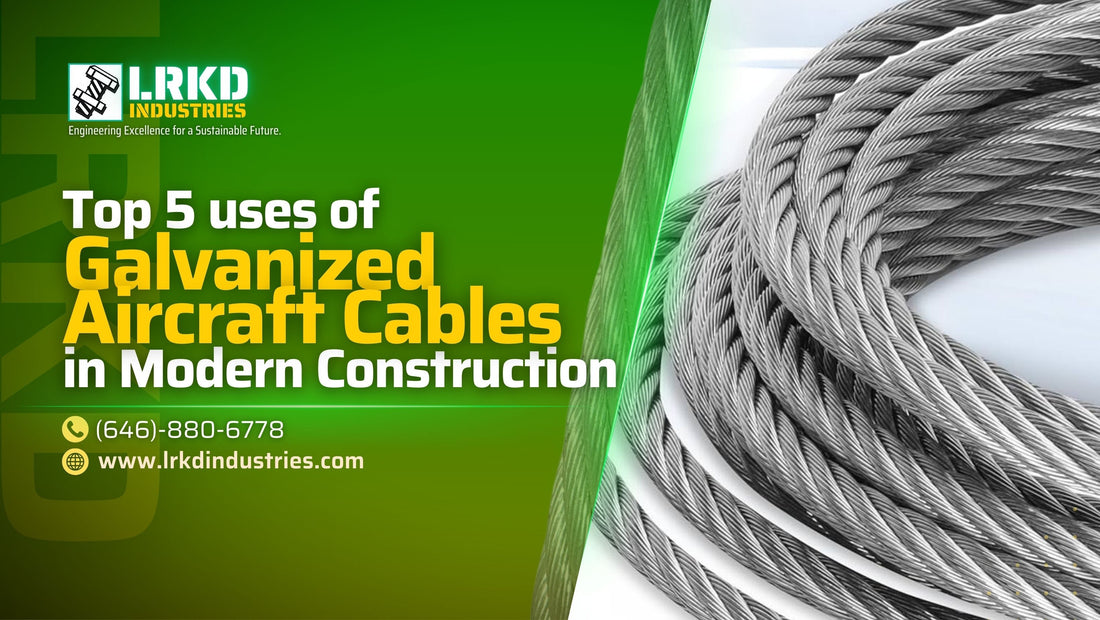When you think about cutting-edge construction, what comes to mind? Towering skyscrapers? Sleek suspension bridges? Perhaps intricate industrial machinery? Behind these feats of engineering is a less glamorous but equally critical component: aircraft cables. Known for their strength, flexibility, and durability, these cables are not just for aviation; they’ve become indispensable in modern construction.
Aircraft cables, also known as wire ropes, are multi-strand steel wires twisted into a helical structure. These marvels of engineering are prized for their high tensile strength and corrosion resistance. But how exactly are they shaping the world of construction today? Let’s delve into the top five ways aircraft cables are revolutionizing the industry.
1. Suspension Bridges: The Backbone of Connectivity
Suspension bridges are architectural wonders that rely on aircraft cables to carry massive loads. The cables act as the primary support system, distributing weight evenly and maintaining the structural integrity of the bridge. Think of iconic landmarks like the Golden Gate Bridge or Brooklyn Bridge – their longevity and strength owe much to these resilient cables.
Why aircraft cables? Their high strength-to-weight ratio makes them ideal for spanning long distances. They’re also resistant to harsh weather conditions, ensuring bridges remain safe and functional for decades. When you walk across a suspension bridge, it’s like stepping onto the shoulders of engineering giants, supported by these humble yet powerful strands.
Pro Tip: Regular maintenance of cables, including inspections for corrosion or fraying, ensures their longevity and safety.
2. Elevators: Lifting Modern Life
Can you imagine urban life without elevators? Skyscrapers, malls, and even apartment complexes rely on aircraft cables to safely and efficiently transport people and goods. These cables are integral to counterweight systems that keep elevators balanced and smooth in operation.
A real-world example is the Burj Khalifa in Dubai, the tallest building in the world. Its high-speed elevators use advanced wire rope systems to ensure passenger safety and comfort. The flexibility and durability of aircraft cables make them a go-to choice for such demanding applications.
Fun Fact: Aircraft cables used in elevators are meticulously tested to endure millions of cycles, ensuring they perform flawlessly for years.
3. Safety Nets and Railings: Subtle Yet Essential
Safety is non-negotiable in construction. Aircraft cables are often used to create safety nets, guardrails, and protective barriers, preventing accidents and ensuring a secure work environment. Whether it’s a high-rise under construction or a pedestrian walkway, these cables provide reliable support.
Take the High Line in New York City, a once-abandoned railway track transformed into a stunning elevated park. Aircraft cables form the sleek railings that ensure visitor safety without obstructing the view. Their unobtrusive design is a testament to how functionality and aesthetics can coexist.
Tip for Architects: Incorporate aircraft cables into safety designs for a minimalist yet robust solution.
4. Tension Structures: Where Art Meets Engineering
Tension structures are celebrated for their innovative designs, combining form and function in architectural masterpieces. From stadium roofs to exhibition halls, aircraft cables are crucial in maintaining the tension that keeps these structures stable.
One remarkable example is the Millennium Dome (now The O2) in London. The roof’s iconic design relies on a network of aircraft cables to hold its shape. These cables’ ability to withstand enormous tensile forces allows architects to push creative boundaries while ensuring structural integrity.
Architectural Insight: Tension systems using aircraft cables allow for lightweight and cost-effective designs without compromising strength.
5. Cranes and Hoists: Powering Heavy Lifting
In construction, moving heavy loads with precision is vital, and aircraft cables are the unsung heroes in this task. Cranes, hoists, and winches depend on these cables to lift and position materials safely and efficiently.
For instance, during the construction of the Hoover Dam, aircraft cables were used to transport massive concrete blocks into place. Modern construction sites continue to rely on these cables for their unmatched strength and flexibility, ensuring projects progress smoothly.
Safety Tip: Always ensure proper tensioning and load limits when using aircraft cables in heavy machinery.
A Cable’s Worth in Construction
Aircraft cables might not be the flashiest part of modern construction, but they’re undoubtedly among the most vital. From iconic bridges and skyscrapers to safety systems and artistic designs, their applications are as diverse as they are essential.
Next time you marvel at a suspension bridge or ride an elevator, take a moment to appreciate the silent strength of aircraft cables. These unassuming strands hold the weight of modern infrastructure, literally and metaphorically. Whether you’re an engineer, architect, or construction enthusiast, understanding their role underscores the importance of innovation and reliability in shaping our world.
So, what role will aircraft cables play in your next project? The possibilities are as boundless as the cables themselves.
Top Applications of Aircraft Cables in Modern Construction
Reinforce your builds with confidence! Aircraft cables aren’t just for aviation—they’re a trusted solution in today’s construction sites for their unmatched strength and flexibility. Whether you’re securing structures, lifting loads, or installing architectural elements, these cables are engineered to perform.
Contact LRKD Industries now to learn more about this versatile construction solution!
👉 Submit your plans today for a FREE consultation on integrating aircraft cables into your next project.
📍 Address: 98 N Industry CT, Deer Park, NY 11729, US
📞 Phone: +1 646-880-6778
📧 Email: info@lrkdindustries.com
We also offer file conversions into “.dwg” format for seamless use with Tekla—ensuring streamlined integration with your modeling and fabrication process.
For more information about our aircraft cable inventory and configurations, click here.
When every connection matters, durability and precision lead the way.


